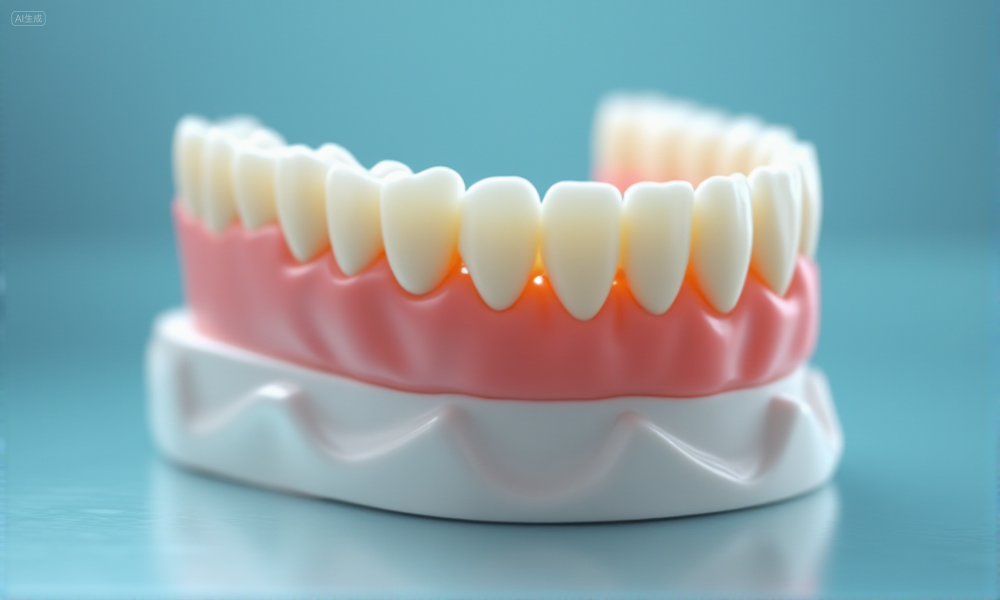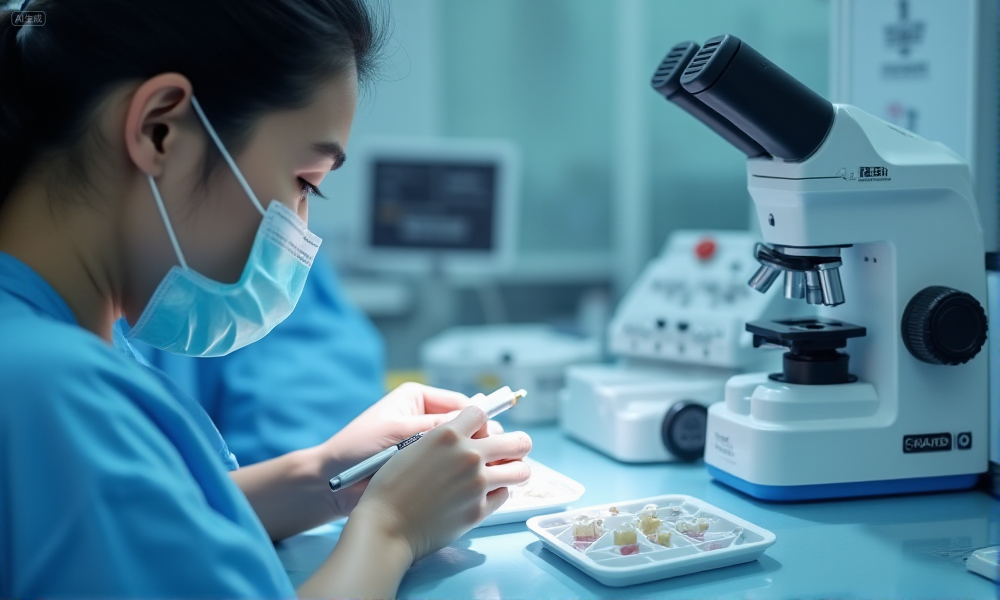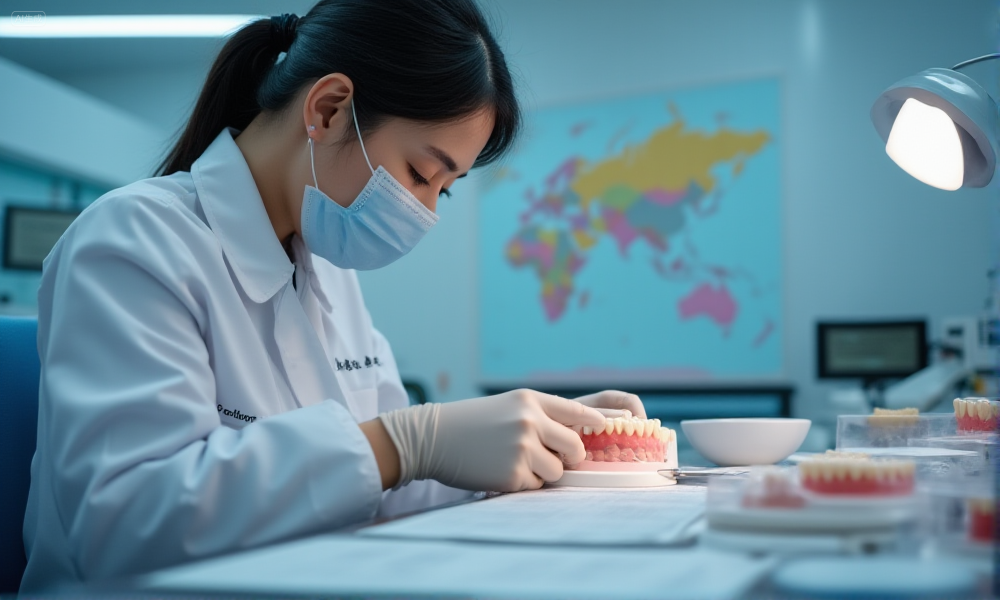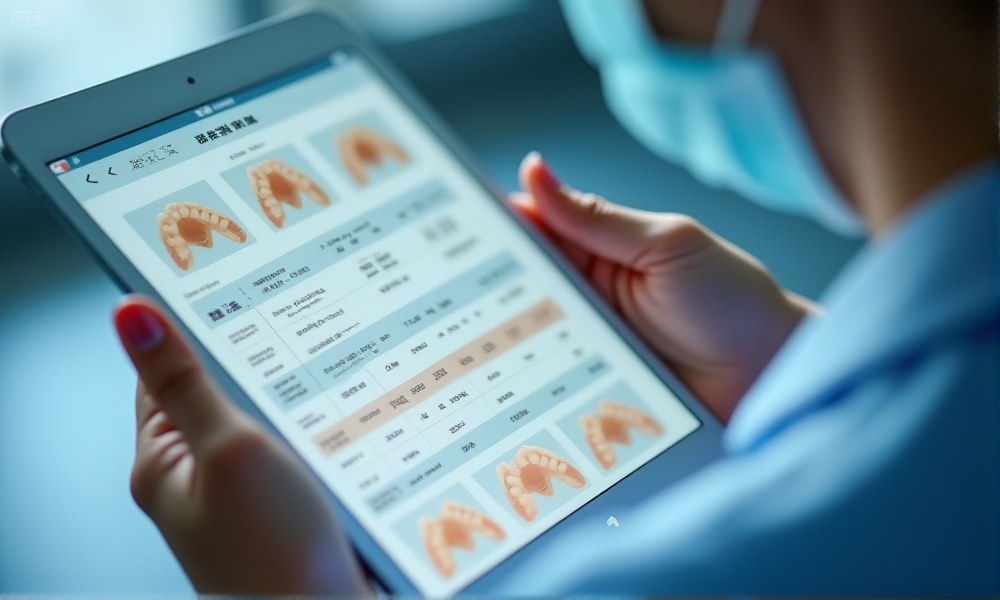Before partnering with a dental implant lab, asking the right questions can reveal how well they meet your clinical standards, workflow requirements, and long-term business goals. Decisions should be based on measurable evidence, not assumptions, ensuring the lab’s capabilities, reliability, and integrity are clear from the outset.
Key factors to evaluate include:
- Experience & Reputation – Years in business, volume of implant restorations completed monthly, technician certifications (e.g., ISO 13485, CDT), and proven client retention.
- Quality & Materials – Documented quality control procedures, ADA- and FDA-approved materials, use of genuine manufacturer parts, and clear remake or adjustment policies.
- Digital Workflow Readiness – Support for CAD/CAM formats like STL, compatibility with scanners such as iTero or 3Shape, and technician proficiency in digital design and manufacturing.
- Turnaround & Delivery – Average production timelines for crowns, bridges, and custom abutments, rush order capabilities, and global logistics management.
- Pricing & Value – Transparent, itemized cost structures, volume discounts or partnership pricing, and clear terms for additional fees.
- Communication & Coordination – Dedicated points of contact, structured case planning, responsive updates, and support across time zones.
By addressing these areas early, procurement teams can select a lab that enhances operational efficiency, safeguards quality, and integrates seamlessly into their workflow—supporting predictable outcomes for both practice and patient.
How to verify a dental implant lab’s track record and reputation
Before committing to a partnership, procurement teams should confirm that a dental implant lab has the experience, credentials, and client feedback to back up its promises. The most reliable partners have a documented history of quality work, formal certifications, and a proven approach to client support.

Dental-implant-lab-certifications
How many years have you been in business, and what is your core implant expertise?
- Years in operation – Labs with 10+ years in the implant sector tend to have refined workflows and robust supplier relationships.
- Specialization areas – Look for labs that can demonstrate expertise in specific implant restoration types, such as full-arch zirconia or custom abutments.
- Adaptability – Longevity combined with a history of adopting new technologies signals resilience.
An Australian distributor told us they switched to our overseas dental lab after learning we had over 15 years of focused implant work, including complex angled screw-channel restorations.
Can you provide references or examples of completed implant restoration cases?
- Reference checks – Speaking with current clients offers candid feedback.
- Case portfolios – Review before-and-after images and documented outcomes.
- Diversity of cases – Look for variety across single-unit, bridge, and full-arch cases.
One European DSO requested a mixed portfolio of anterior esthetic cases and posterior load-bearing cases before awarding a three-year supply contract.
What certifications or accreditations does the lab hold (ISO 13485, CDT, DAMAS)?
- ISO 13485 – Confirms compliance with international medical device quality standards.
- CDT certification – Validates technician skill and knowledge.
- DAMAS accreditation – Demonstrates adherence to documented quality systems.
A Middle Eastern partner fast-tracked vendor approval after verifying our ISO, CDT, and DAMAS credentials.
How does the lab approach client support and problem-solving?
Beyond technical output, a lab’s responsiveness in resolving issues often defines its reputation. Look for dedicated account managers, escalation protocols, and documented case-resolution timelines. In our experience, having a 24-hour initial response commitment builds confidence and prevents delays in active cases.
By combining verification of history, case evidence, and formal credentials with an understanding of the lab’s support culture, procurement teams can confidently identify trustworthy partners.
How does the lab ensure quality, material integrity, and compliance?
An implant lab’s ability to maintain high quality, material authenticity, and regulatory compliance is essential for both clinical outcomes and procurement risk management. The most reliable labs combine rigorous quality control processes with certified materials and genuine components.

Dental-lab-quality-control-compliance
What quality control processes are in place to ensure accuracy and precision?
- Incoming material inspection – All metals, ceramics, and polymers verified against supplier documentation.
- In-process checks – Critical dimensions like margin fit and occlusion reviewed at multiple stages.
- Final verification – Finished restorations compared against the digital design, with photographic documentation archived.
One UK-based client reduced remake rates by 25% after aligning with our staged QC workflow.
Are all materials ADA- and FDA-approved, and do you offer biocompatible options?
- ADA compliant materials – Ensure restorations meet professional safety and performance standards.
- FDA-registered products – Confirm adherence to US biocompatibility requirements.
- Biocompatible alternatives – Offer patient-specific solutions for allergy or sensitivity cases.
An Australian clinic passed a hospital procurement audit without delays after switching to FDA-registered zirconia from our overseas dental lab.
Do you use genuine manufacturer parts and hardware for implant restorations?
- Original abutments and screws – Prevent fit issues and premature failure.
- Traceable supply chain – Documented sourcing from verified manufacturers.
- Warranty integrity – Maintains manufacturer guarantees for implant systems.
One Middle Eastern distributor avoided warranty disputes by requiring OEM part documentation for all custom abutments.
How do you handle remakes or adjustments if a case does not meet specifications?
Effective labs have clear remake policies, prioritizing root cause analysis to prevent recurrence. Our standard protocol includes immediate client notification, technical review within 24 hours, and prioritized remake production to minimize clinical disruption.
By combining strict QC, certified materials, genuine parts, and a proactive remake policy, a lab demonstrates its commitment to consistent, compliant, and trustworthy implant restorations.
What are the lab’s digital workflow capabilities and technician expertise?
A lab’s ability to integrate digital workflows efficiently—and the skill level of its technicians—directly affects case accuracy, turnaround speed, and client satisfaction. A capable partner combines system compatibility, direct scanner integration, and advanced technical training.

Dental-lab-digital-workflow-capabilities
Which CAD/CAM systems and file formats are supported (STL, iTero, 3Shape)?
- Universal STL compatibility – Accepts industry-standard formats without conversion delays.
- Native iTero and 3Shape integration – Maintains data integrity from scan to design.
- Cross-platform readiness – Supports a range of CAD/CAM systems for flexibility in client workflows.
A UK-based practice cut data transfer time by 40% after switching to a lab with native iTero integration.
Can you accept digital impressions directly from my preferred scanner?
- Direct portal uploads – Securely receive scans without email or manual transfers.
- Multi-scanner capability – Accepts data from leading intraoral scanners.
- Automated file management – Prevents mislabeling or case mix-ups.
One Canadian clinic avoided multiple case delays after their lab adopted direct uploads from their scanner of choice.
How does your workflow integrate digital impressions into final restorations?
Efficient labs link digital impressions directly to CAD/CAM production. Our process involves importing the scan, verifying margin accuracy, designing in 3D, and milling restorations in-house—minimizing data loss and reducing remake risk. This workflow ensures that every stage, from impression to delivery, remains connected and traceable.
Are your technicians trained in the latest digital design and manufacturing tools?
- Ongoing training programs – Keeps skills aligned with software updates and new tools.
- Hands-on CAD/CAM experience – Ensures accurate translation from digital design to physical restoration.
- Specialization in implant cases – Technicians familiar with complex abutment and full-arch designs.
A Middle Eastern distributor maintained consistent first-time fit rates above 98% after partnering with a lab whose CAD team had formal training on the latest 3D design tools.
Combining advanced digital workflow capabilities with skilled technicians allows a lab to deliver faster, more accurate results—strengthening collaboration and clinical outcomes.
What is the expected turnaround time and delivery reliability?
Turnaround time and delivery reliability directly impact treatment schedules and patient satisfaction. A dependable lab not only meets agreed deadlines but also adapts to urgent needs while ensuring smooth global delivery.

Dental-implant-lab-turnaround-delivery
What is the average production time for implant crowns, bridges, and custom abutments?
- Single-unit crowns – Typically 5–7 lab working days from scan to dispatch.
- Multi-unit bridges – Usually 7–10 lab working days, depending on complexity.
- Custom abutments – Often 6–8 lab working days with design verification.
A Scandinavian clinic improved case scheduling accuracy after aligning with our overseas dental lab’s production timelines.
Do you offer expedited production for urgent or emergency cases?
- Priority scheduling – Moves urgent cases to the front of the production queue.
- Resource reallocation – Assigns additional technicians for high-priority work.
- Same-day design approval – Speeds up fabrication start times.
One Middle Eastern distributor reduced patient waiting time by four days through our expedited production protocol.
How do you manage shipping, customs clearance, and global delivery schedules?
- Partnering with reliable global shipping carriers – Ensures consistent transit times.
- Pre-cleared customs documentation – Minimizes border delays.
- Real-time tracking – Keeps clients informed from dispatch to delivery.
An Australian dental group avoided a two-week holiday delay because our logistics team pre-cleared all customs paperwork in advance.
Labs that combine accurate production scheduling with responsive expedited options and efficient logistics create a reliable supply chain that clients can trust.
How transparent and sustainable is the lab’s pricing?
Pricing transparency and sustainability are essential for building long-term, trust-based partnerships. A clear structure ensures both parties understand costs, while sustainable models align incentives for consistent quality and service.

Dental-implant-lab-pricing-transparency
Can you provide a clear and itemized price list for implant restorations?
- Detailed breakdown – Includes material type, restoration type, and fabrication steps.
- Accessible format – Digital and print versions for quick reference.
- Regular updates – Reflects changes in material costs or market conditions.
One European distributor reduced procurement disputes by adopting a standardized, itemized price list from our overseas dental lab.
Do you offer volume discounts or long-term partnership pricing models?
- Tiered discounts – Incentivize larger orders with lower per-unit costs.
- Partnership pricing – Fixed rates for long-term agreements to stabilize budgeting.
- Hybrid models – Combine volume discounts with custom pricing for unique cases.
A North American DSO locked in cost savings for three years by committing to a partnership pricing model tied to quarterly order volumes.
How do you calculate and communicate additional charges (e.g., shipping, rush orders)?
- Pre-approved rates – Shared in advance for predictable budgeting.
- Transparent triggers – Clear criteria for when extra charges apply.
- Itemized invoicing – Lists all surcharges separately for review.
An Australian clinic avoided unexpected costs during peak season because all rush and shipping fees were disclosed upfront.
Labs that provide transparent, sustainable pricing structures make it easier for clients to forecast costs, allocate budgets, and invest in long-term collaboration with confidence.
How does the lab handle communication and case coordination?
A lab’s communication structure and coordination processes directly influence workflow efficiency, case accuracy, and client satisfaction. The most reliable partners have clear points of contact, predictable response times, and structured planning protocols.

Dental-implant-lab-communication-coordination
Who will be my primary point of contact for ongoing case updates?
- Dedicated account manager – Serves as the single point of contact for all cases.
- Role clarity – Clearly defines responsibilities for communication, technical support, and logistics.
- Backup contacts – Ensures continuity during absences or holidays.
A US-based clinic improved case turnaround by 15% after being assigned a dedicated lab coordinator for all communications.
How quickly can I expect responses across different time zones?
- Response time commitments – Agreed targets for acknowledging and resolving inquiries.
- Shift overlap scheduling – Enables real-time collaboration despite time zone differences.
- Escalation protocols – Fast-tracks urgent issues to senior technicians or managers.
One European DSO reduced project delays by implementing a 12-hour maximum response policy with their implant lab partner.
How do you manage case planning to ensure alignment with the dental office?
Strong labs coordinate case planning through shared schedules, treatment planning sessions, and regular status reviews. Our overseas dental lab typically aligns milestones with the clinic’s patient booking system, ensuring design, fabrication, and delivery are synchronized. This proactive alignment reduces last-minute changes and minimizes chairside adjustments.
Labs that combine clear points of contact, prompt responses, and integrated planning processes build trust and keep projects on track—no matter the distance or time difference.
These questions help screen for a reliable partner, but they’re only part of the picture. For a complete guide on how to evaluate outsourcing options for dental implant production, see the full framework.
Partnering with the right dental implant lab is a strategic decision that shapes clinical outcomes, operational efficiency, and long-term cost control. A well-chosen partner acts as an extension of your team—delivering consistent quality, integrating seamlessly into your digital workflow, and maintaining open communication that keeps cases on schedule.
As an overseas dental lab experienced in global collaboration, we understand the value of predictable turnaround times, precise restorations, and proactive problem-solving. By prioritizing measurable standards—experience, compliance, digital readiness, service responsiveness, and transparent pricing—procurement teams can build partnerships that reduce risk and drive sustainable growth. The result is not just successful individual cases, but a reliable supply chain foundation that supports your practice for years to come.


